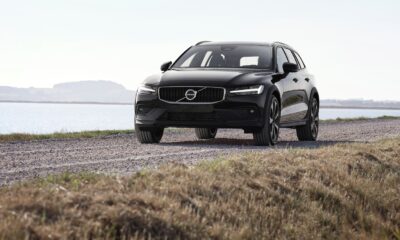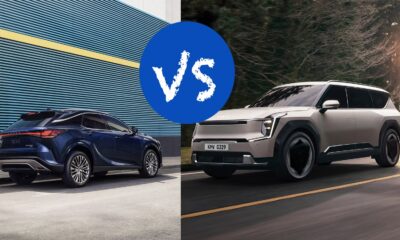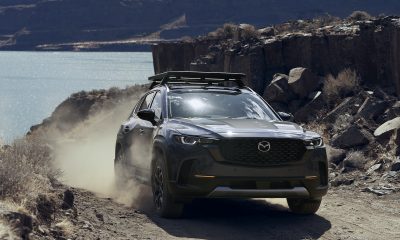Car Reviews
Lexus ES 300h and Volvo S60 Recharge – HARMONIC DIVERGENCE
Lexus ES 300h and Volvo S60 Recharge
HARMONIC DIVERGENCE
If holding off on buying an all-electric vehicle you have it right. Keep waiting.
While you wait, however, you would be wise to invest in one of the many electrified vehicles on the market which can drastically reduce particulate emissions, cut monthly fuel bills by 75%, provide elevated levels of safety and durability, and are – not incidentally – a joy to drive.
We recently tried two, a hybrid Lexus ES and a plug-in hybrid Volvo S60. No, neither requires a high-priced charger. Yes, both have gas tanks.
Change is hard
The Interwebs this week are chock-full of articles announcing the “collapse” of the EV market. Quote marks are appropriate here because, in the day when everyone is a journalist, clicks are king, and hyperbole, especially negative hyperbole, is a shortcut to success.
While honest observers may debate their significance, the transition from internal combustion engines – ICE, in the parlance – to battery electric vehicles (BEV, again – in the parlance) is proving rockier than manufacturers anticipated because of three main obstacles: range anxiety, an incomplete charging network, and high, essentially unaffordable prices.
Here is the thing: all those issues are temporal and have known solutions. The change will come because, worldwide, automakers and allied industries plan to invest $860 billion by 2030 into a technology that is more efficient than the one it replaces. You know, like when the world discovered trucks could more efficiently transport goods to market than horse-drawn wagons.
Hey, none of us likes change. It isn’t the unknown that scares us – it’s the loss of the known.
Still, last week every corporation aiming to build vehicles in North America found itself rejiggering its strategy. This is not only because BEV sales are slow and few affordable ones are on the market, but also because a better mousetrap is on the near horizon, one that promises to make the next generation of electric vehicles far superior to the pricey ones piling up on dealer lots.
Texans, of course, understand this. It is always easy to identify the pioneers; they are the ones with arrows in their backs.
The big winner in all this may be Toyota, which six months ago was seen as a laggard because it was reluctant to develop EVs. Last week, Toyota added its name to the list of manufacturers, including Porsche and Honda, who say they believe it is feasible to mass produce solid-state batteries, which will be smaller, lighter, cheaper to produce, more reliable, quicker to charge, and provide 400 to 800 miles of range, depending on the mass and aerodynamics of the vehicle.
The road from the lab to the factory floor is long and scientifically rigorous. Toyota says it expects to see solid-state batteries in cars by 2027-28. Proof-of-concept testing emerging from multiple players – manufacturers and would-be suppliers – established an engineering consensus that this is feasible, indeed, likely. Both Ford and General Motors in recent weeks hit the brakes on battery plants under construction to reevaluate engineering and product design strategies.
This is not to say that it is wise to continue to drive gas guzzlers that damage the climate and open a funnel from your wallet to oil producers, some downright unfriendly to America and her allies.
Hybrid vehicles, on the market for a quarter-century, save fuel and are indisputably more dependable than ICEs because electric motors have 1/10 as many moving parts and do the heavy lifting, which allows the gas engines to last longer. Fears about the cost of replacing batteries are the result of propaganda whipped up by the oil industry’s well-financed lobbying and influence-peddling machine.
If you do not believe me, give me a call and we will go for a spin in the 17-year-old Toyota Highlander Hybrid sitting in front of my house. The battery is outlasting the paint job. At this point, most vehicles would need a new engine and transmission, about three times the cost of an all-new battery – which I do not need.
The Highlander stays on the street because Blonde Bride’s brand-new Ford Escape plug-in hybrid – PHEV in the parlance – gets to sleep in the garage.
In addition to a gas-electric hybrid system, her SUV has a battery that recharges on a standard wall outlet and gives her about 40 miles of electric-only driving. Six weeks in, the gas tank is still full. As best I can figure – it will be months before she buys gas – she is getting around 435 miles per gallon.
A 35-mile round trip to visit her BFF in Hooks, for example, is all-electric. In the first month we had the Escape our electric bill went up two bucks, but that is misleading. During the same month, I tested two other PHEVs, so half the time we had two cars plugged in at night.
What happens if we go on a long trip? We have a full gas tank in a pleasant, comfortable, safe, and digitally sophisticated car that gets 40 mpg.
PHEVs are eligible for federal income tax credits of up to $7,500. Regular hybrids are not.
Why I love this job
There are worse things than trying to figure out which I like more: the Lexus ES 300h or Volvo S60 Recharge. Though both are lovely, they employ starkly different strategies when it comes to ride, handling, and the use of hybridization.
The S60 takes the concept of GT (Grand Tourer) to a new level, offering astonishing performance and handling in a luxury venue. The ES 300h is tuned for comfort and serenity. Both are formidable contenders, each embodying a unique blend of style, performance, and advanced features.
Ride, Handling, and Performance:
The Lexus ES 300h epitomizes refined comfort, offering a smooth and calm ride. Its suspension system adeptly absorbs road irregularities, providing a plush and controlled experience. While not designed for spirited driving, the ES 300h’s precise steering and composed handling inspire confidence on the road. With its hybrid powertrain, a 2.5-liter, four-cylinder gas engine running on the Atkinson cycle coupled with a powerful electric motor and a hybrid transaxle, the ES has a combined 215 total system horsepower and an EPA-estimated MPG rating of 43/44/44.
Acceleration is smooth and powerful. The battery pack gives the Lexus a low center of gravity so handling, while leisurely, is also sure-footed.
The ES 300h prioritizes fuel efficiency, while the S60 Recharge AWD Ultimate embraces electrification for enhanced performance, along with efficiency. It has a smaller, rechargeable battery that gives it 40 miles of all-electric power after an overnight charge.
Mash on the gas pedal, however, and the S60 Recharge takes off like a Toyota SR Supra. A rear-mounted electric motor and front-mounted, performance-tuned 2.0-L turbocharged four-cylinder ICE unleash 455 combined horsepower and 523 lb.-ft. of torque. It is enough to slam heads against seatbacks and power the car from zero to 60 in 4.0 seconds. That is faster than an Aston Martin Vantage V8, an Audi R8, a Dodge Challenger Scat Pack 392 and dead even with a BMW iX xDrive 50.
With a computer vectoring torque and braking to each of the four wheels as needed and a low, center-mounted battery pack, the S60 Recharge whips through curves like a sidewinder seeking sustenance, gracefully slithering across the asphalt with mesmerizing agility and control.
The Lexus ES 300h delivered a steady 44 mpg. Fuel economy on the Volvo PHEV is a subjective issue. On its own, the gas-electric hybrid system is not as efficient as the Lexus, delivering around 30 mpg, but actual mileage certainly depends on how one drives; specifically, what percentage of driving is all-electric and what amount is gas-electric.
Driving around town, for example, even with the lead foot, we averaged around 107 mpg. On a 200-mile road trip, our average dropped to 37 mpg. For the week, we averaged 74.1 mpg, which is precisely what the EPA estimates a typical driver will attain.
Cabin comfort
Both sedans exude luxury and craftsmanship. The ES 300h highlights impeccable diligence, with high-quality materials and a serene ambiance. Its spacious interior provides generous legroom for both front and rear passengers, ensuring a comfortable journey. The S60 Recharge AWD Ultimate offers a modern and minimalist cabin design, featuring premium materials and contemporary styling elements. While slightly more compact, the S60’s well-appointed interior still offers ample comfort for occupants.
Exterior aesthetics
The Lexus ES 300h wins this one. It boasts an elegant and sophisticated exterior, characterized by its signature spindle grille, sleek lines, and refined proportions. Its timeless design exudes a sense of understated luxury and class.
On the other hand, the Volvo S60 Recharge’s minimalism causes it to fade into the background. It would be a perfect surveillance vehicle. It looks like an FBI pool car.
The Lexus looks like, well, a Lexus.
User interface and switchgear
Lexus has not been known for an intuitive and user-friendly infotainment system, but the ES 300h breaks the mold. Apple CarPlay, for example, loaded almost immediately and had zero glitches. The ES multimedia interface features a responsive touchscreen, complemented by physical controls for essential functions. The system is straightforward to navigate.
Similarly, the Volvo S60 Recharge AWD Ultimate impresses with its user-friendly Sensus infotainment system. Its vertically-oriented touchscreen provides a modern and visually appealing interface, although it may require slight acclimation.
Seat comfort
Both the Lexus ES 300h and Volvo S60 Recharge prioritize passenger comfort with well-designed seating. The ES 300h offers plush, supportive seats that cradle occupants during long drives, while available ventilated and heated seats further enhance comfort.
The S60 Recharge presents ergonomically designed seats that provide excellent support and adjustability. With optional massage and ventilation functions, the S60 further elevates the seating experience.
Driver-assist technology and safety
Both brands have well-deserved reputations as leaders in safety.
The Lexus ES 300h incorporates an array of advanced driver-assist technologies, including adaptive cruise control, lane-keeping assist, and automated emergency braking. Its comprehensive safety suite assists drivers in navigating the road with confidence.
The Volvo places a strong emphasis on safety, equipping its sedan with an extensive suite of standard and optional safety features. Its innovative Pilot Assist system combines adaptive cruise control and lane-keeping assist, providing semi-autonomous driving capabilities.
Neither of these is self-driving, but both have digital co-pilots that always pay attention.









































